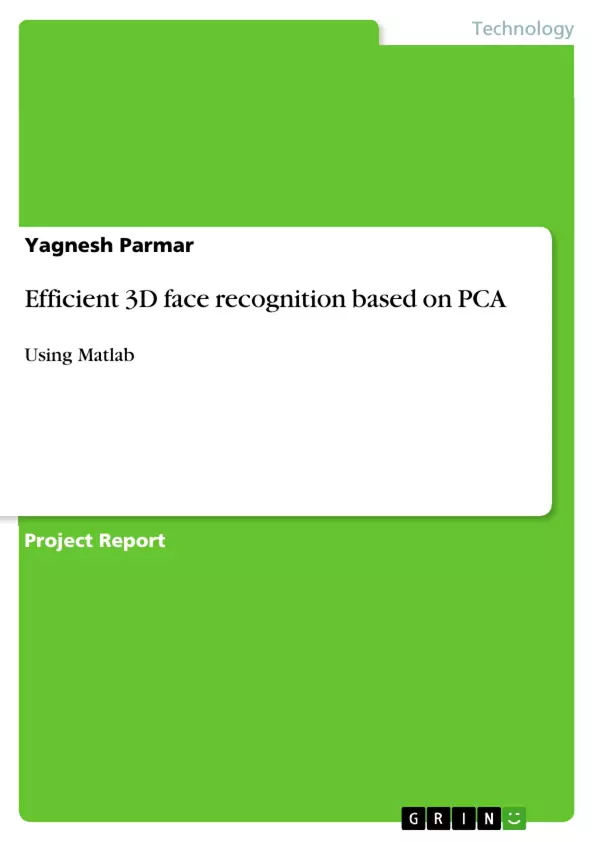This thesis describes a face recognition system that overcomes the problem of changes in gesture and mimics in three-dimensional (3D) range images. Here, we propose a local variation detection and restoration method based on the two-dimensional (2D) principal component analysis (PCA). The depth map of a 3D facial image is first smoothed using median filter to minimize the local variation. The detected face shape is cropped & normalized to a standard image size of 101x101 pixels and the forefront nose point is selected to be the image center. Facial depthvalues are scaled between 0 and 255 for translation and scaling-invariant identification. The preprocessed face image is smoothed to minimize the local variations. The 2DPCA is applied to the resultant range data and the corresponding principal-(or eigen-) images are used as the characteristic feature vectors of the subject to find his/her identity in the database of pre-recorded faces.
The system's performance is tested against the GavabDB facial databases. Experimental results show that the proposed method is able to identify subjects with different gesture and mimics in the presence of noise in their 3D facial image.
Inhaltsverzeichnis (Table of Contents)
- I. INTRODUCTION
- II. BACK GROUND AND REVIEW OF PAST WORK
- III. MAIN WORK
- A. Preprocessing stage
- B. Feature extraction using PCA
- IV. IMPLEMENTATION & RESULTS
- A. Data base
- B. Experiment results and matching
- V. CONCLUSION
Zielsetzung und Themenschwerpunkte (Objectives and Key Themes)
This research aims to develop a face recognition system that overcomes the challenges posed by changes in facial expressions and gestures in 3D range images. The system utilizes a local variation detection and restoration method based on 2D principal component analysis (PCA) to address these issues.- 3D Face Recognition System Development
- Overcoming Challenges of Facial Expression and Gesture Variations
- Local Variation Detection and Restoration
- Application of 2D PCA for Feature Extraction
- Performance Evaluation using GavabDB Database
Zusammenfassung der Kapitel (Chapter Summaries)
I. INTRODUCTION
This chapter introduces the problem of face recognition in 3D range images, highlighting the challenges posed by variations in facial expressions and gestures. It emphasizes the need for an efficient and robust system that can handle these changes while maintaining usability on contemporary computational devices. The chapter outlines the advantages of 3D face recognition over 2D approaches and emphasizes the ongoing challenge of internal deformation in 3D images.II. BACK GROUND AND REVIEW OF PAST WORK
This chapter provides a review of existing 3D face recognition research, focusing on approaches that utilize both depth and color information. It discusses various techniques, including Eigenfaces, curvature feature extraction, 3D eigenfaces, and PCA-based approaches. The chapter highlights limitations in existing systems, such as dependence on high-quality 3D data and difficulties in handling changes in facial expressions and poses.III. MAIN WORK
This chapter presents the proposed face recognition system, which includes a preprocessing stage and a feature extraction stage using 2D PCA. The preprocessing stage involves smoothing, alignment, cropping, and normalization of the facial image to minimize local variations. The feature extraction stage utilizes 2D PCA to extract principal components, which serve as feature vectors for classification. The chapter explains the process of range image representation and provides a detailed description of the preprocessing and feature extraction stages.IV. IMPLEMENTATION & RESULTS
This chapter discusses the implementation and evaluation of the proposed system using the GavabDB database. It outlines the database characteristics, including the number of individuals and images per person, as well as the systematic variations in pose and facial expressions. The chapter presents experimental results, demonstrating the system's ability to identify subjects with different facial expressions in the presence of noise. It also investigates the impact of median filter size on recognition rate.Schlüsselwörter (Keywords)
This research focuses on developing a 3D face recognition system capable of handling facial expression and gesture variations in 3D range images. The primary methodology involves utilizing 2D Principal Component Analysis (PCA) for feature extraction and local variation detection. The system's performance is evaluated against the GavabDB database, emphasizing the importance of robust recognition in the presence of noise. Key terms include: 3D PCA, VRML, Eigen Faces, 3D Face, Local Variation Detection, 2D PCA, GavabDB.- Citation du texte
- Yagnesh Parmar (Auteur), 2012, Efficient 3D face recognition based on PCA, Munich, GRIN Verlag, https://www.grin.com/document/203464



